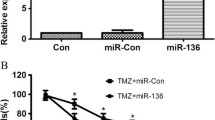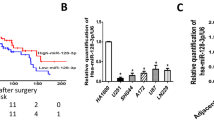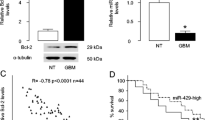Abstract
Glioblastoma (GBM) is the most malignant and challenging type of astrocytoma and also notoriously acknowledged as the most common primary brain tumor globally. Currently, chemotherapy is the most master therapy for tumor and is essential in clinical treatment for GBM. Nevertheless, the characterization of chemotherapy resistance seriously hinders clinical chemotherapy treatment. Accordingly, there are imperious demands for the exploitation of novel chemosensitizer to promote the efficacy of chemotherapy. Our current study was conducted to probe into the potential impacts of microRNA (miR)-640 on the chemosensitivity in GBM and the associated underlying mechanism. Initially, TargetScan software was utilized to predict the targeted genes of miR-640, and the target relationship between miR-640 and Bcl-2-modifying factor (BMF) was validated by double luciferase report assay. Additionally, to explore the role of miR-640/BMF in U251 cells, miR-640 inhibitor/BMF-siRNA was used. U251 cells were processed with 100 μM temozolomide (TMZ) and detected with CCK-8 kit. Eventually, RT-qPCR and Western blotting were used for evaluating Bcl-2, Bax mRNA, and protein expression level. Flow cytometry analysis was performed to measure cellular apoptosis. Initially, the results indicated that BMF was the target gene of miR-640. MiR-640 negatively regulated BMF expression in GBM cells. Besides, the findings revealed that miR-640 inhibition significantly inhibited U251 cell proliferation, promoted cell apoptosis, and increased the sensitivity of GBM cells to TMZ by targeting BMF. Moreover, BMF overexpression significantly suppressed U251 cell proliferation, induced cell apoptosis, and increased the sensitivity of GBM cells to TMZ. Inhibition of miR-640 expression enhances chemosensitivity of human GBM cells to TMZ by targeting BMF.






Similar content being viewed by others
Data Availability
The datasets used and/or analyzed during the current study are available from the corresponding author on reasonable request.
References
Au TH, Willis C, Reblin M, Peters KB, Nghiemphu PL, Taylor JW et al (2022) Caregiver burden by treatment and clinical characteristics of patients with glioblastoma. Support Care Cancer 30(2):1365–1375
Contreras AU, Mebratu Y, Delgado M, Montano G, Hu CA, Ryter SW et al (2013) Deacetylation of p53 induces autophagy by suppressing Bmf expression. J Cell Biol 201(3):427–437
Fan YX, Bian XH, Qian PD, Chen ZZ, Wen J, Luo YH et al (2018) MicroRNA-125b inhibits cell proliferation and induces cell apoptosis in esophageal squamous cell carcinoma by targeting BMF. Oncol Rep 40(1):61–72
Gramantieri L, Fornari F, Ferracin M, Veronese A, Sabbioni S, Calin GA et al (2009) MicroRNA-221 targets Bmf in hepatocellular carcinoma and correlates with tumor multifocality. Clin Cancer Res 15(16):5073–5081
Hanada R, Leibbrandt A, Hanada T, Kitaoka S, Furuyashiki T, Fujihara H et al (2009) Central control of fever and female body temperature by RANKL/RANK. Nature 462(7272):505–509
Harel S, Sanchez-Gonzalez V, Echavarria R, Mayaki D, Hussain SN (2020) Roles of miR-640 and zinc finger protein 91 (ZFP91) in angiopoietin-1-induced in vitro angiogenesis. Cells. https://doi.org/10.3390/cells9071602
Jiang D, Sun X, Wang S, Man H (2019) Upregulation of miR-874-3p decreases cerebral ischemia/reperfusion injury by directly targeting BMF and BCL2L13. Biomed Pharmacother 117:108941
Kang Y, Nian H, Rajendran P, Kim E, Dashwood WM, Pinto JT et al (2014) HDAC8 and STAT3 repress BMF gene activity in colon cancer cells. Cell Death Dis 5:e1476
Karachi A, Dastmalchi F, Mitchell DA, Rahman M (2018) Temozolomide for immunomodulation in the treatment of glioblastoma. Neuro Oncol 20(12):1566–1572
Kirikoshi H, Sekihara H, Katoh M (2001) Molecular cloning and characterization of WNT14B, a novel member of the WNT gene family. Int J Oncol 19(5):947–952
Laba AE, Ziolkowski P (2021) Trends in glioblastoma treatment research: an analysis of clinical trials and literature. Neurol Neurochir Pol 55(3):269–280
Li JH, Liu S, Zhou H, Qu LH, Yang JH (2014) starBase v2.0: decoding miRNA-ceRNA, miRNA-ncRNA and protein-RNA interaction networks from large-scale CLIP-Seq data. Nucl Acids Res. https://doi.org/10.1093/nar/gkt1248
Luo C, Lu Z, Chen Y, Chen X, Liu N, Chen J et al (2021) MicroRNA-640 promotes cell proliferation and adhesion in glioblastoma by targeting Slit guidance ligand 1. Oncol Lett 21(2):161
Masson N, Willam C, Maxwell PH, Pugh CW, Ratcliffe PJ (2001) Independent function of two destruction domains in hypoxia-inducible factor-alpha chains activated by prolyl hydroxylation. EMBO J 20(18):5197–5206
Nikaki A, Piperi C, Papavassiliou AG (2012) Role of microRNAs in gliomagenesis: targeting miRNAs in glioblastoma multiforme therapy. Expert Opin Investig Drugs 21(10):1475–1488
Niu X, Wang C, Zhou X, Yang Y, Liu Y, Zhang Y et al (2021) Pineal region glioblastomas: clinical characteristics, treatment, and survival outcome. World Neurosurg 146:e799–e810
Peng CH, Chen ZX, Wang S, Wang HW, Qiu WJ, Zhao L et al (2016) The error-prone DNA polymerase kappa promotes temozolomide resistance in glioblastoma through rad17-dependent activation of ATR-Chk1 signaling. Cancer Res 76(8):2340–2345
Regazzo G, Terrenato I, Spagnuolo M, Carosi M, Cognetti G, Cicchillitti L et al (2016) A restricted signature of serum miRNAs distinguishes glioblastoma from lower grade gliomas. J Exp Clin Cancer Res 35(1):124
Sul OJ, Rajasekaran M, Park HJ, Suh JH, Choi HS (2019) MicroRNA-29b enhances osteoclast survival by targeting BCL-2-modifying factor after lipopolysaccharide stimulation. Oxid Med Cell Longev 2019:6018180
Tang C, Wang X, Ji C, Zheng W, Yu Y, Deng X et al (2021) The role of miR-640: a potential suppressor in breast cancer via Wnt7b/beta-catenin signaling pathway. Front Oncol 11:645682
Vehlow A, Klapproth E, Jin S, Hannen R, Hauswald M, Bartsch JW et al (2019) Interaction of discoidin domain receptor 1 with a 14-3-3-beclin-1-akt1 complex modulates glioblastoma therapy sensitivity. Cell Rep. https://doi.org/10.1016/j.celrep.2019.02.096
Xiong Y, Chen R, Wang L, Wang S, Tu Y, Zhu L et al (2019) Downregulation of miR186 promotes the proliferation and drug resistance of glioblastoma cells by targeting twist1. Mol Med Rep 19(6):5301–5308
Yee YH, Chong SJ, Pervaiz S (2016) The anti-oxidant and pro-oxidant dichotomy of Bcl-2. Biol Chem 397(7):585–593
Yuan GQ, Wei NL, Mu LY, Wang XQ, Zhang YN, Zhou WN et al (2017) A 4-miRNAs signature predicts survival in glioblastoma multiforme patients. Cancer Biomark 20(4):443–452
Zhai Z, Fu Q, Liu C, Zhang X, Jia P, Xia P et al (2019) Emerging roles of hsa-circ-0046600 targeting the miR-640/HIF-1alpha signalling pathway in the progression of HCC. Onco Targets Ther 12:9291–9302
Funding
This study was supported by the Scientific Research Project of Wuhan Municipal Health Commission (Grant No. WX21C05).
Author information
Authors and Affiliations
Contributions
SJ and CL contributed to the study design, data collection, statistical analysis, data interpretation, and manuscript preparation. YC, JC, ST, and QZ contributed to data collection and statistical analysis. CH and SD contributed to data collection, statistical analysis, and manuscript preparation. All authors read and approved the final manuscript.
Corresponding authors
Ethics declarations
Competing interests
The authors declare no competing interests.
Conflict of interest
The authors declare that they have no competing interests.
Additional information
Publisher's Note
Springer Nature remains neutral with regard to jurisdictional claims in published maps and institutional affiliations.
Supplementary Information
Below is the link to the electronic supplementary material.
Rights and permissions
Springer Nature or its licensor holds exclusive rights to this article under a publishing agreement with the author(s) or other rightsholder(s); author self-archiving of the accepted manuscript version of this article is solely governed by the terms of such publishing agreement and applicable law.
About this article
Cite this article
Jiang, S., Luo, C., Chen, Y. et al. MicroRNA-640 Inhibition Enhances the Chemosensitivity of Human Glioblastoma Cells to Temozolomide by Targeting Bcl2 Modifying Factor. Biochem Genet 61, 538–550 (2023). https://doi.org/10.1007/s10528-022-10264-x
Received:
Accepted:
Published:
Issue Date:
DOI: https://doi.org/10.1007/s10528-022-10264-x




